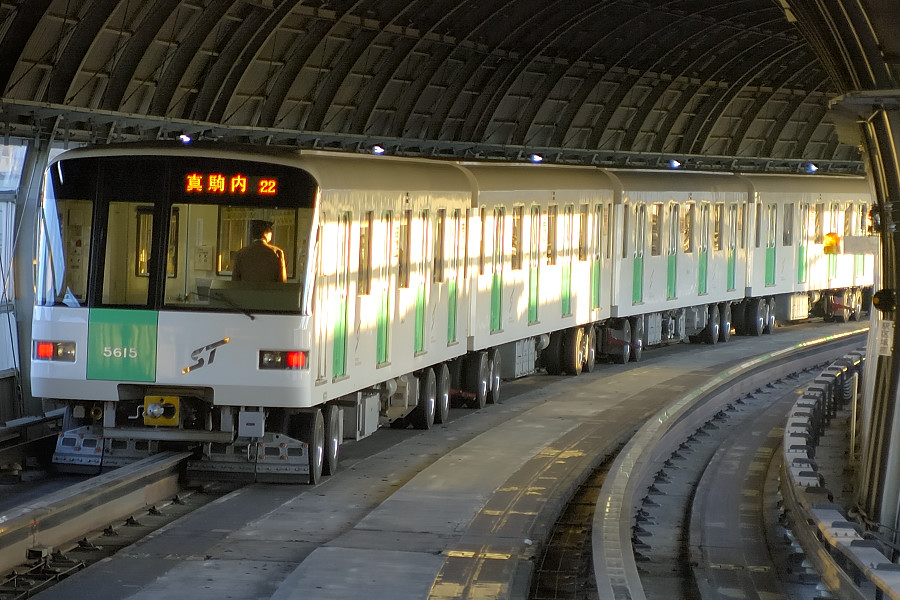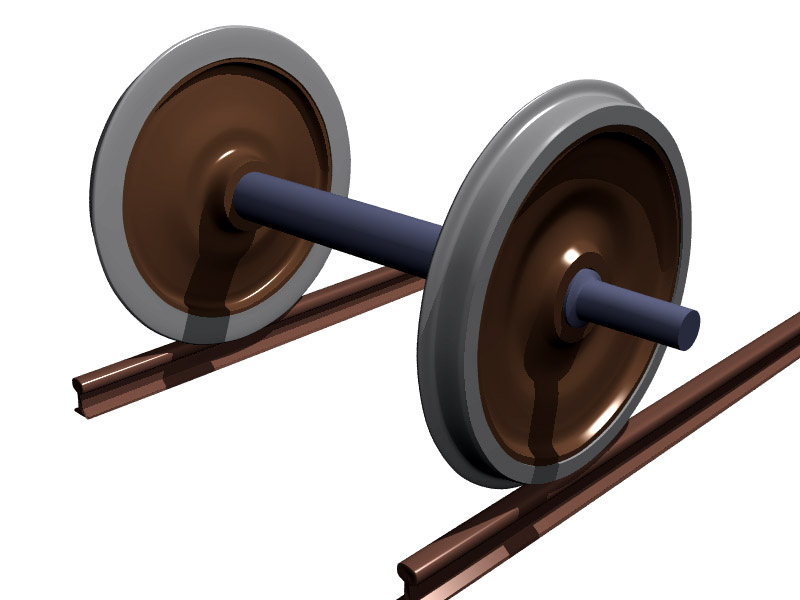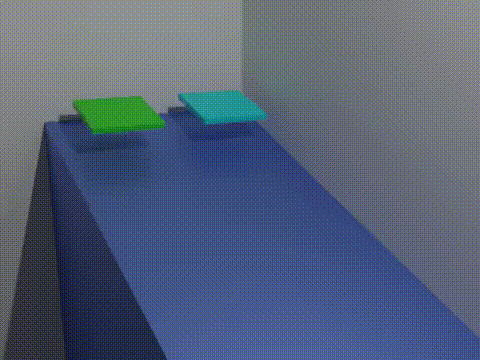|
MF88
The MF 88 (; ) is a steel-wheel variant of electric multiple units used on Paris's Métro system. RATP contracted a consortium of manufacturers, with Ateliers du Nord de la France in charge of the project. They were built following successful tests of a prototype train-set called the "BOA", derived from the MF 77, which tested new features such as open gangway connections between cars to improve passenger distribution and special bogies to reduce friction caused by the sharp curves found in the Métro network. The MF 88 introduced a number of innovations in its time, including AC induction motors and an on-board computer system using a new standard integrated computing architecture. It is planned for the MF 19 CC rolling stock to replace the MF 88 in 2026. Design Carrying on the features of the BOA, a total of nine MF 88 train-sets were built, which have only ever operated on Line 7bis in a three-car formation. It was the first model with AC motors, suppli ... [...More Info...] [...Related Items...] OR: [Wikipedia] [Google] [Baidu] |
MF 88
The MF 88 (; ) is a steel-wheel variant of electric multiple units used on Paris's Métro system. RATP contracted a consortium of manufacturers, with Ateliers du Nord de la France in charge of the project. They were built following successful tests of a prototype train-set called the "BOA", derived from the MF 77, which tested new features such as open gangway connections between cars to improve passenger distribution and special bogies to reduce friction caused by the sharp curves found in the Métro network. The MF 88 introduced a number of innovations in its time, including AC induction motors and an on-board computer system using a new standard integrated computing architecture. It is planned for the MF 19 CC rolling stock to replace the MF 88 in 2026. Design Carrying on the features of the BOA, a total of nine MF 88 train-sets were built, which have only ever operated on Line 7bis in a three-car formation. It was the first model with AC motors, sup ... [...More Info...] [...Related Items...] OR: [Wikipedia] [Google] [Baidu] |
MF88
The MF 88 (; ) is a steel-wheel variant of electric multiple units used on Paris's Métro system. RATP contracted a consortium of manufacturers, with Ateliers du Nord de la France in charge of the project. They were built following successful tests of a prototype train-set called the "BOA", derived from the MF 77, which tested new features such as open gangway connections between cars to improve passenger distribution and special bogies to reduce friction caused by the sharp curves found in the Métro network. The MF 88 introduced a number of innovations in its time, including AC induction motors and an on-board computer system using a new standard integrated computing architecture. It is planned for the MF 19 CC rolling stock to replace the MF 88 in 2026. Design Carrying on the features of the BOA, a total of nine MF 88 train-sets were built, which have only ever operated on Line 7bis in a three-car formation. It was the first model with AC motors, suppli ... [...More Info...] [...Related Items...] OR: [Wikipedia] [Google] [Baidu] |
Paris Métro
The Paris Métro (, , or , ), short for Métropolitain (), is a rapid transit system serving the Paris metropolitan area in France. A symbol of the city, it is known for its density within the capital's territorial limits, uniform architecture and Paris Métro entrances by Hector Guimard, historical entrances influenced by Art Nouveau. The system is long, mostly underground. It has 321 stations of which 61 have transfers between lines. The Montmartre funicular is considered to be part of the metro system within which is represented by a 303rd fictive station, "Funiculaire".Statistiques Syndicat des transports d'Île-de-France rapport 2005' (in French) states 297 stations + Olympiades + Les Agnettes + Les Courtilles The Métro has sixteen lines (with an additional Grand Paris Express, four under construction), numbered 1 to 14, with two lines, Paris Métro Line 3bis, Line 3bis and Paris Métro Line 7bis, Line 7bis, named because they used to be part of Paris Métro Line 3, Lin ... [...More Info...] [...Related Items...] OR: [Wikipedia] [Google] [Baidu] |
Paris Métro Line 7bis
Paris Métro Line 7bis is one of sixteen lines on the Paris Métro. It connects Louis Blanc in the 10th arrondissement of Paris, 10th arrondissement to Pré Saint-Gervais in the 19th arrondissement of Paris, 19th arrondisement in the north-eastern part of the city. With a length of 3.1 kilometres (1.9 mi) and eight stations, the line is the second shortest on the Paris Métro, only longer than Paris Métro Line 3bis, Line 3bis. The line was opened in 1911, then operating as a branch of Paris Métro Line 7, Line 7. However, due to a large difference in passenger numbers between this branch and the other Line 7 branch (then operating as far as Porte de la Villette (Paris Métro), Porte de La Vilette), the branch was separated from Line 7, forming Line 7bis. Chronology *18 January 1911: The section between Louis Blanc and Pré-Saint-Gervais was opened as a branch of Paris Métro Line 7, Line 7. *3 December 1967 : Because of a lack of traffic, the branch became a separate li ... [...More Info...] [...Related Items...] OR: [Wikipedia] [Google] [Baidu] |
Traction Motor
A traction motor is an electric motor used for propulsion of a vehicle, such as locomotives, electric vehicle, electric or hydrogen vehicles, or electric multiple unit trains. Traction (engineering), Traction motors are used in electrically powered railway vehicles (electric multiple units) and other electric vehicles including electric milk floats, trolleybuses, elevators, roller coasters, and conveyor systems, as well as vehicles with electrical transmission systems (Diesel locomotive#Transmission types, diesel–electric locomotives, electric hybrid vehicles), and battery electric vehicles. Traction motor companies The word ''traction'' from Latin, being the Agent (grammar), agent noun of ''trahere'' "to pull" in the sense of "drawn" was used for the naming of traction engines developed circa 1870. The first experimental electric traction motor tramway of 1875 was rapidly developed internationally for city use. In the 19th century traction motor passenger car companies ... [...More Info...] [...Related Items...] OR: [Wikipedia] [Google] [Baidu] |
Gate Turn-off Thyristor
A gate turn-off thyristor (GTO) is a type of high-power (e.g. 1200 V AC) thyristor that unlike a normal thyristor is fully controllable and can be turned On and Off by their gate lead. It was invented by General Electric. Device description Normal thyristors ( silicon-controlled rectifiers) are not fully controllable switches (a fully controllable switch can be turned on and off at will). Thyristors can only be turned on using the gate lead, but cannot be turned off using the gate lead. Thyristors are switched on by a gate signal, but even after the gate signal is de-asserted (removed, reverse biased), the thyristor remains in the on state until a turn-off condition occurs (which can be the application of a reverse voltage to the terminals or a decrease of the forward current below a certain threshold value known as the ''holding current''). Thus, a thyristor behaves like a normal semiconductor diode after it is turned on, or ''fired''. The GTO can be turned on by a ... [...More Info...] [...Related Items...] OR: [Wikipedia] [Google] [Baidu] |
Railbus
A railbus is a lightweight passenger railcar with an automotive engine. It shares many aspects of its construction with a bus, typically having a bus (original or modified) body and four wheels (2 axles) on a fixed base instead of on bogies. Originally designed and developed during the 1930s, railbuses have evolved into larger dimensions with characteristics similar in appearance to a light railcar, with the terms ''railcar'' and ''railbus'' often used interchangeably. Railbuses designed for use specifically on little-used railway lines were commonly employed in countries such as Germany, Italy, France, the United Kingdom, and Sweden. Today, railbuses are being replaced by modern, light Railcar#New-generation DMU and EMU railcars, DMU railcar designs. Modern diesel-electric railcars, which can be run coupled as multiple units, like the Stadler RS1, the RegioSprinter of Siemens, or the successor Siemens Desiro, share the role and specifications with railbuses (albeit with improv ... [...More Info...] [...Related Items...] OR: [Wikipedia] [Google] [Baidu] |
Rubber-tyred Metro
A rubber-tyred metro or rubber-tired metro is a form of rapid transit system that uses a mix of road transport, road and rail transport, rail technology. The vehicles have wheels with rubber tires that run on a roll way inside guide bars for traction. Traditional, Flange, flanged steel wheels running on rail tracks provide guidance through Railroad switch, switches and act as backup if tyres fail. Most rubber-tyred trains are purpose-built and designed for the system on which they operate. Guided buses are sometimes referred to as 'trams on tyres', and compared to rubber-tyred metros. History The first idea for rubber-tyred railway vehicles was the work of Scotsman Robert William Thomson, the original inventor of the pneumatic tire, tyre. In his patent of 1846 he describes his 'Aerial Wheels' as being equally suitable for, "the ground or rail or track on which they run". The patent also included a drawing of such a railway, with the weight carried by pneumatic main wheels runnin ... [...More Info...] [...Related Items...] OR: [Wikipedia] [Google] [Baidu] |
Axle
An axle or axletree is a central shaft for a rotation, rotating wheel and axle, wheel or gear. On wheeled vehicles, the axle may be fixed to the wheels, rotating with them, or fixed to the vehicle, with the wheels rotating around the axle. In the former case, bearing (mechanical), bearings or Bushing (bearing), bushings are provided at the mounting points where the axle is supported. In the latter case, a bearing or bushing sits inside a central hole in the wheel to allow the wheel or gear to rotate around the axle. Sometimes, especially on bicycles, the latter type of axle is referred to as a ''spindle (tool), spindle''. Terminology On cars and trucks, several senses of the word ''axle'' occur in casual usage, referring to the shaft itself, its housing, or simply any transverse pair of wheels. Strictly speaking, a shaft that rotates with the wheel, being either Bolt (fastener), bolted or rotating spline, splined in fixed relation to it, is called an ''axle'' or ''axle shaft ... [...More Info...] [...Related Items...] OR: [Wikipedia] [Google] [Baidu] |
Chassis
A chassis (, ; plural ''chassis'' from French châssis ) is the load-bearing framework of a manufactured object, which structurally supports the object in its construction and function. An example of a chassis is a vehicle frame, the underpart of a motor vehicle, on which the body is mounted; if the running gear such as wheels and transmission, and sometimes even the driver's seat, are included, then the assembly is described as a rolling chassis. Examples Vehicles In the case of vehicles, the term ''rolling chassis'' means the frame plus the "running gear" like engine, transmission, drive shaft, differential, and suspension. The "rolling chassis" description originated from assembly production when an integrated chassis "rolled on its own tires" just before truck bodies were bolted to the frames near the end of the line. An underbody (sometimes referred to as " coachwork"), which is usually not necessary for the integrity of the structure, is built on the chassis to c ... [...More Info...] [...Related Items...] OR: [Wikipedia] [Google] [Baidu] |
Friction
Friction is the force resisting the relative motion of solid surfaces, fluid layers, and material elements sliding against each other. Types of friction include dry, fluid, lubricated, skin, and internal -- an incomplete list. The study of the processes involved is called tribology, and has a history of more than 2000 years. Friction can have dramatic consequences, as illustrated by the use of friction created by rubbing pieces of wood together to start a fire. Another important consequence of many types of friction can be wear, which may lead to performance degradation or damage to components. It is known that frictional energy losses account for about 20% of the total energy expenditure of the world. As briefly discussed later, there are many different contributors to the retarding force in friction, ranging from asperity deformation to the generation of charges and changes in local structure. When two bodies in contact move relative to each other, due to these variou ... [...More Info...] [...Related Items...] OR: [Wikipedia] [Google] [Baidu] |
Bogie
A bogie ( ) (or truck in North American English) comprises two or more Wheelset (rail transport), wheelsets (two Railroad wheel, wheels on an axle), in a frame, attached under a vehicle by a pivot. Bogies take various forms in various modes of transport. A bogie may remain normally attached (as on many railroad cars and semi-trailers) or be quickly detachable (as for a dolly (trailer), dolly in a road train or in railway bogie exchange). It may include Suspension (vehicle), suspension components within it (as most rail and trucking bogies do), or be solid and in turn be suspended (as are most bogies of continuous track, tracked vehicles). It may be mounted on a swivel, as traditionally on a railway carriage or locomotive, additionally jointed and sprung (as in the landing gear of an airliner), or held in place by other means (centreless bogies). Although ''bogie'' is the preferred spelling and first-listed variant in various dictionaries, bogey and bogy are also used. Rail ... [...More Info...] [...Related Items...] OR: [Wikipedia] [Google] [Baidu] |






